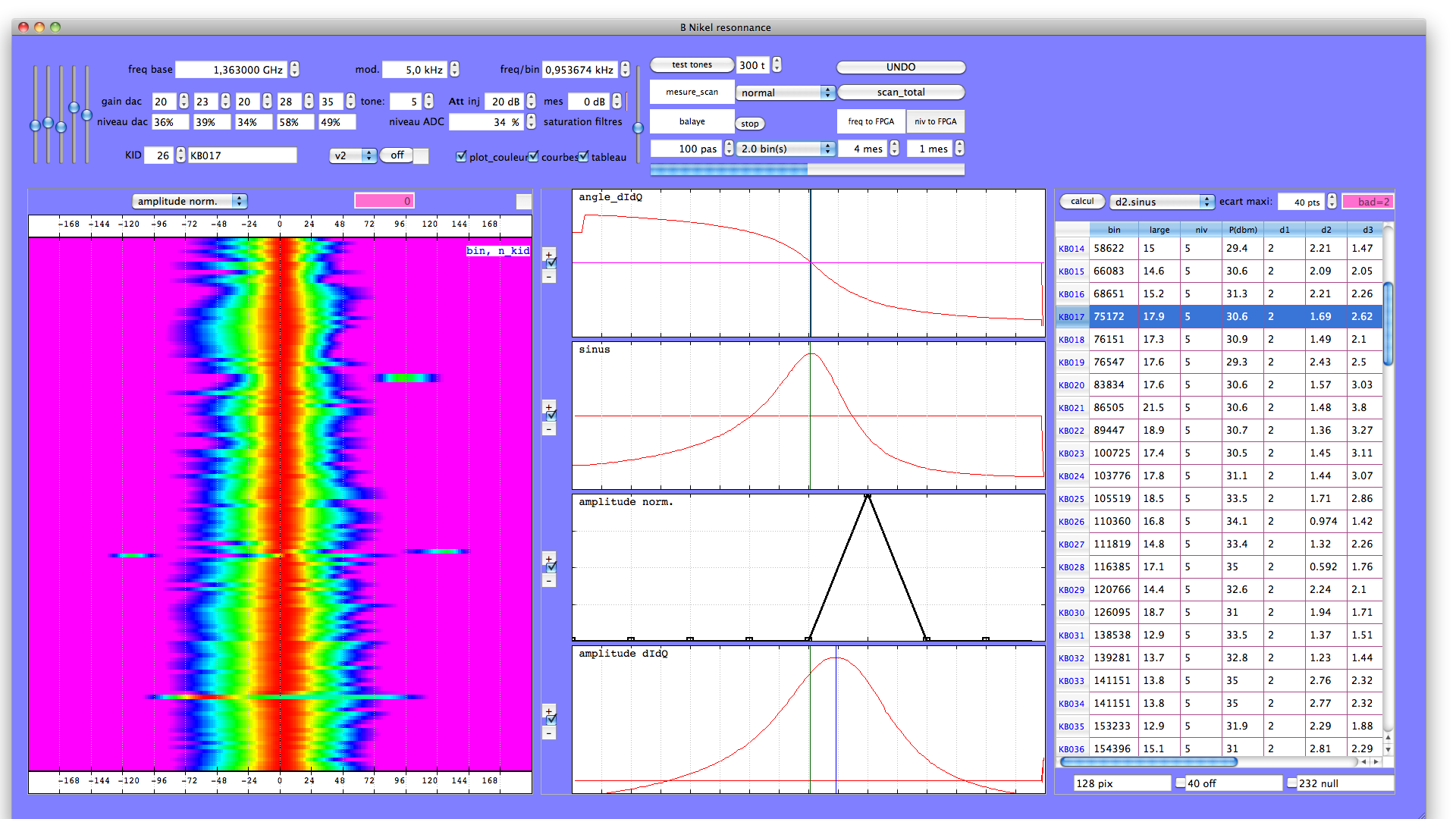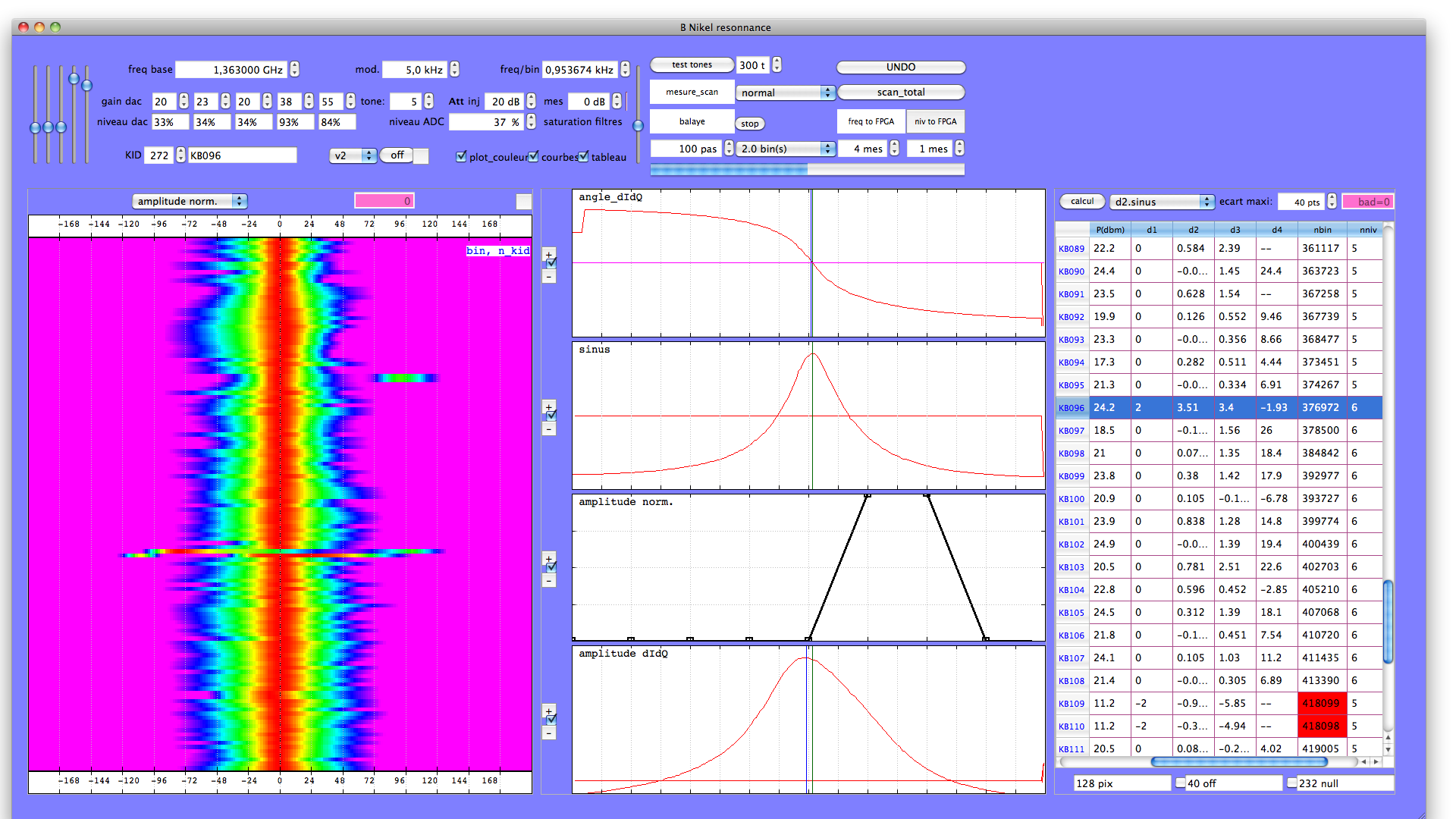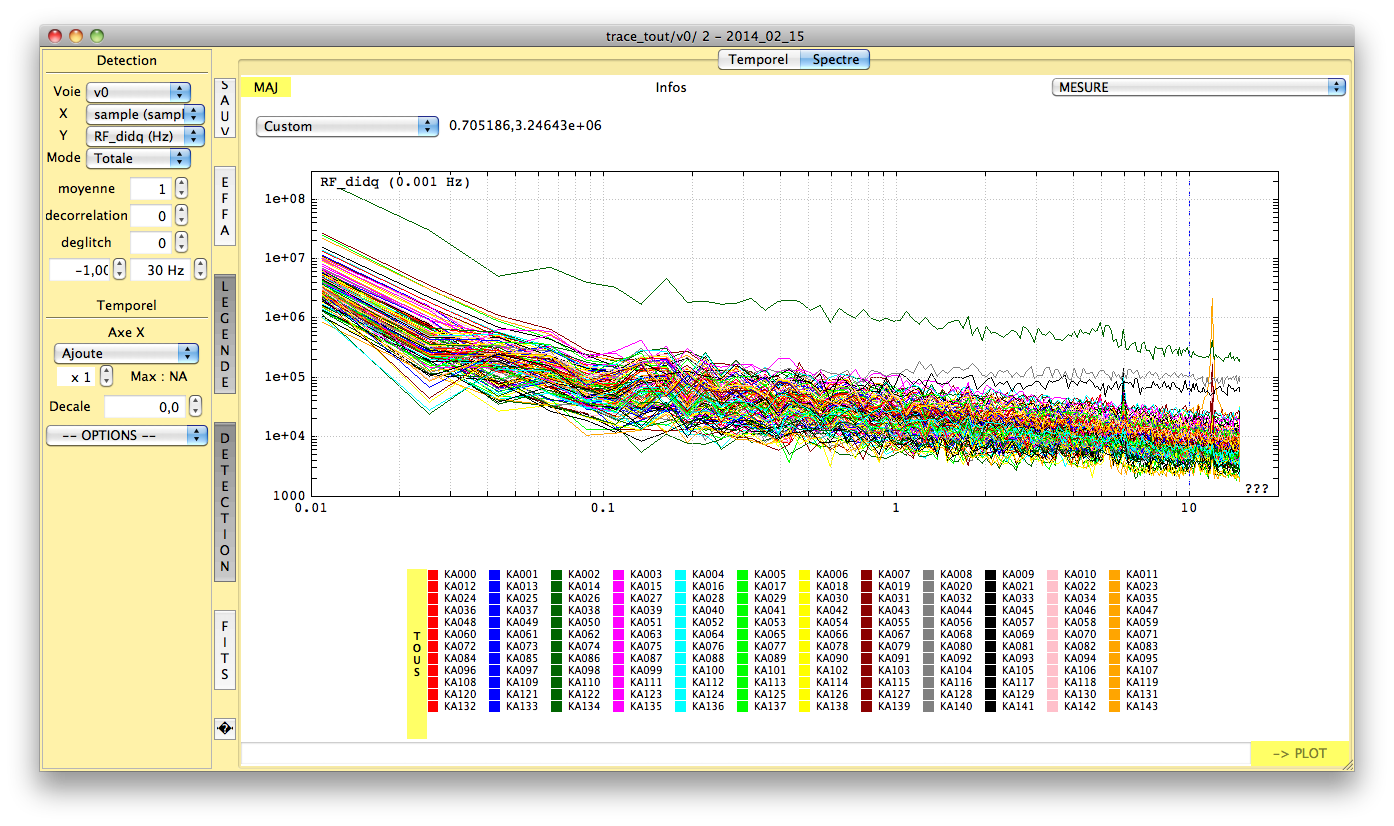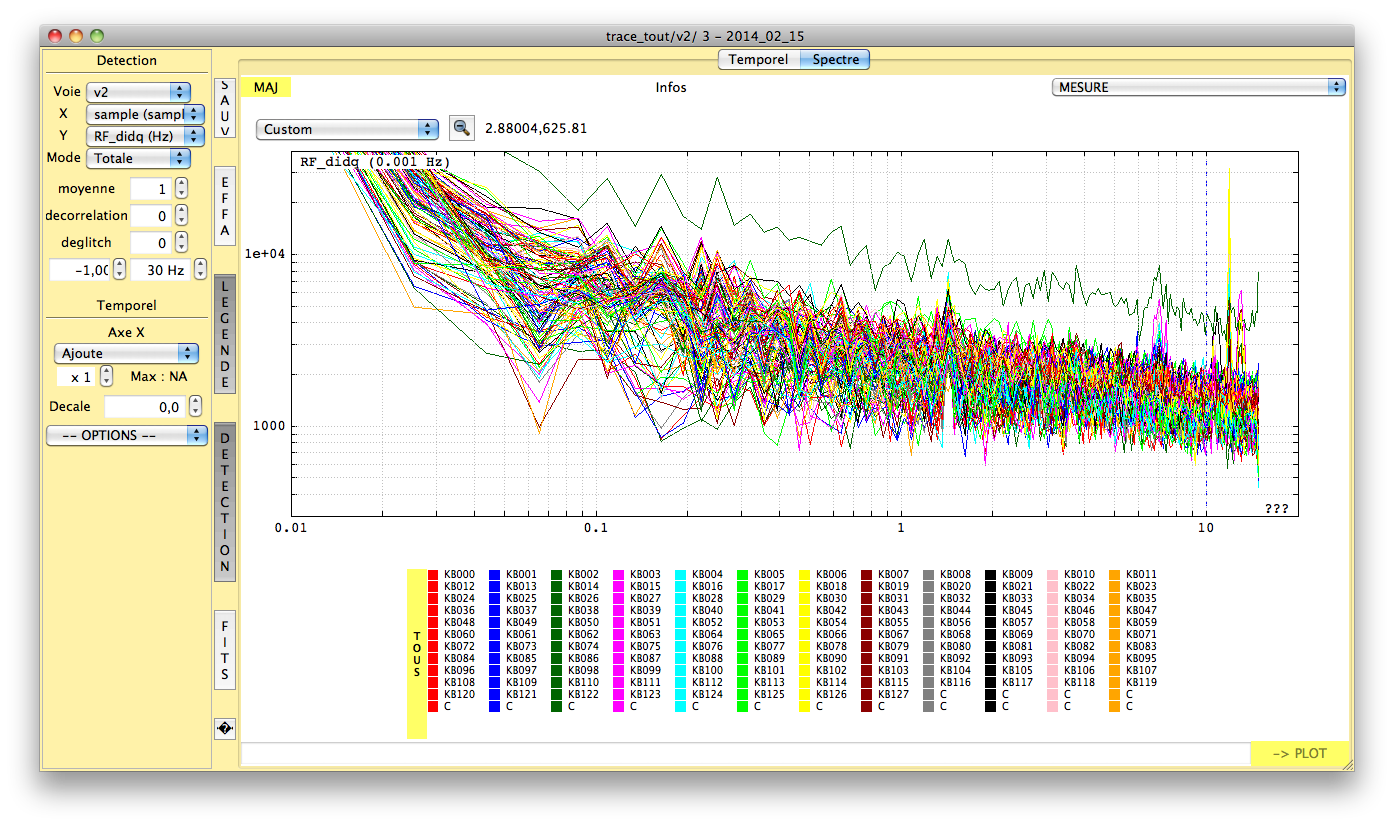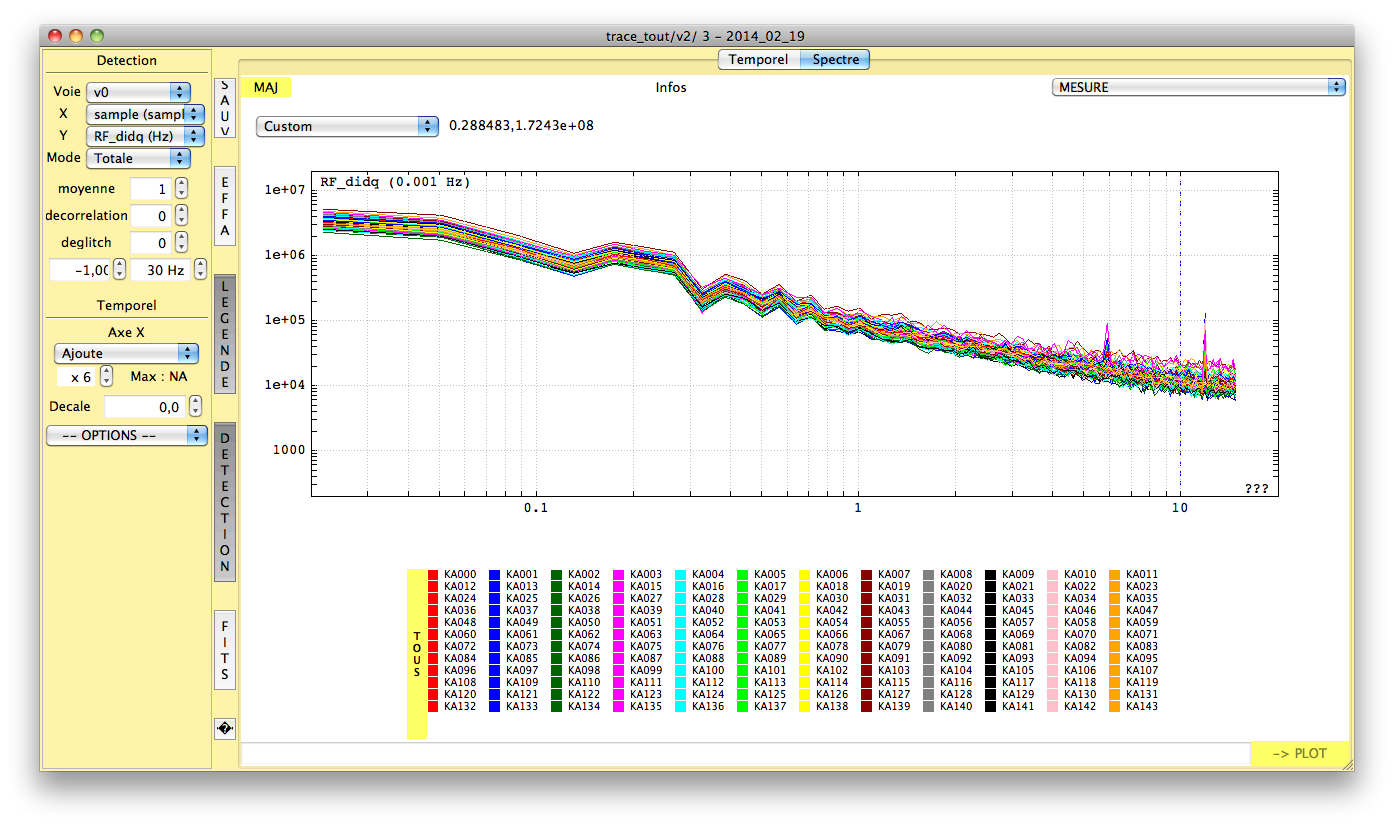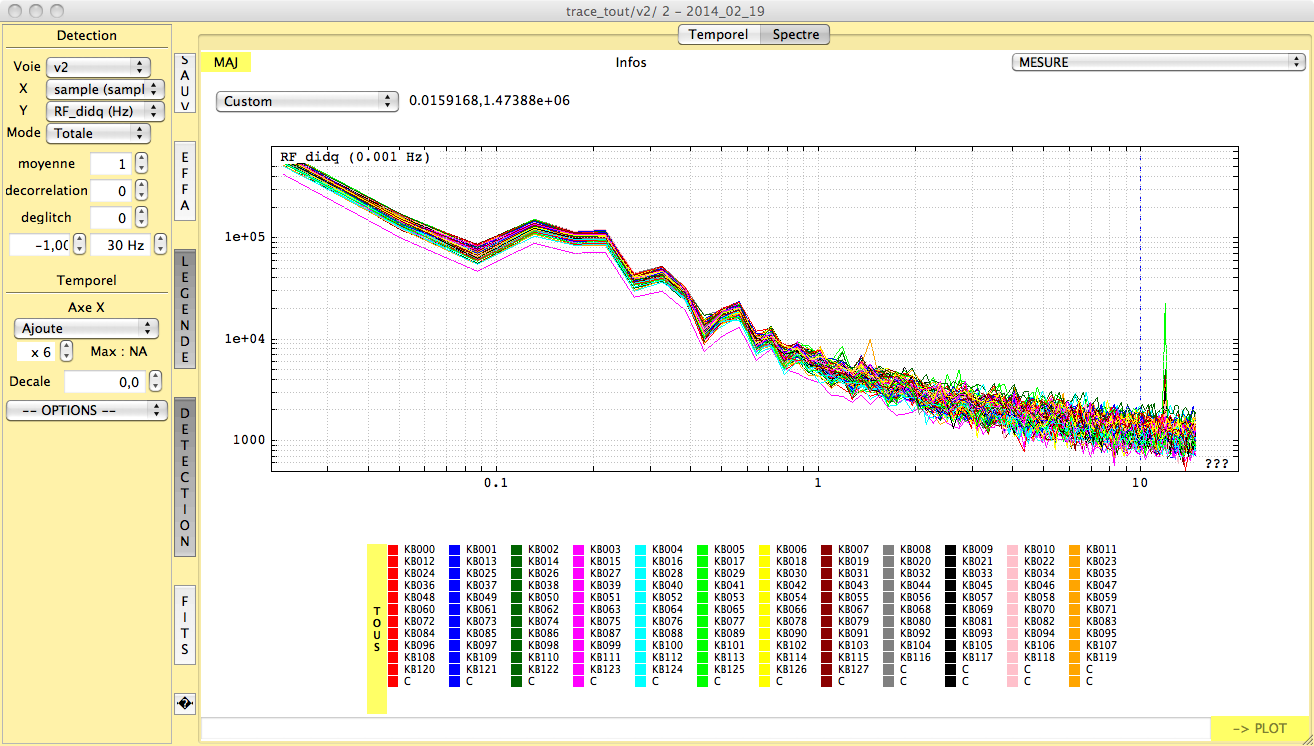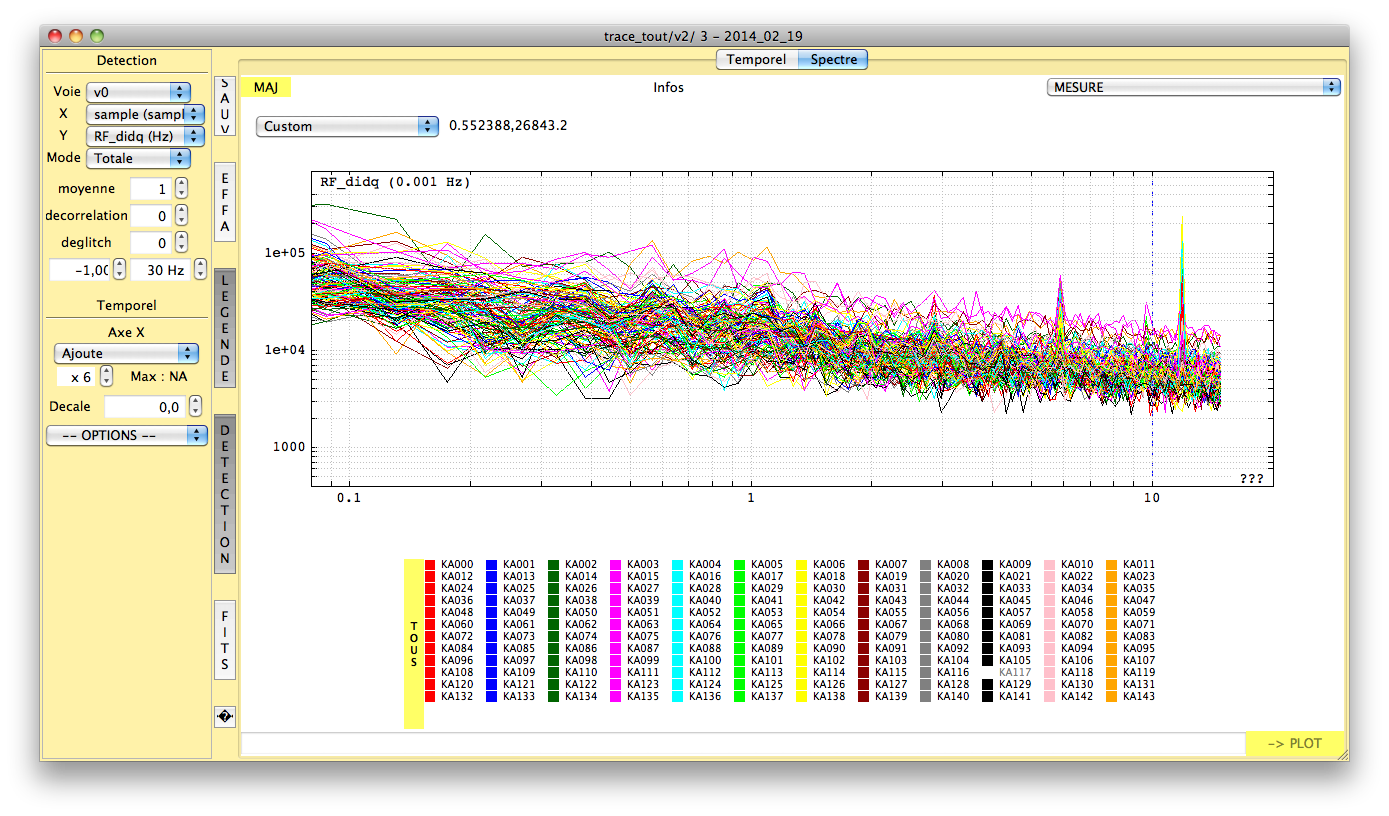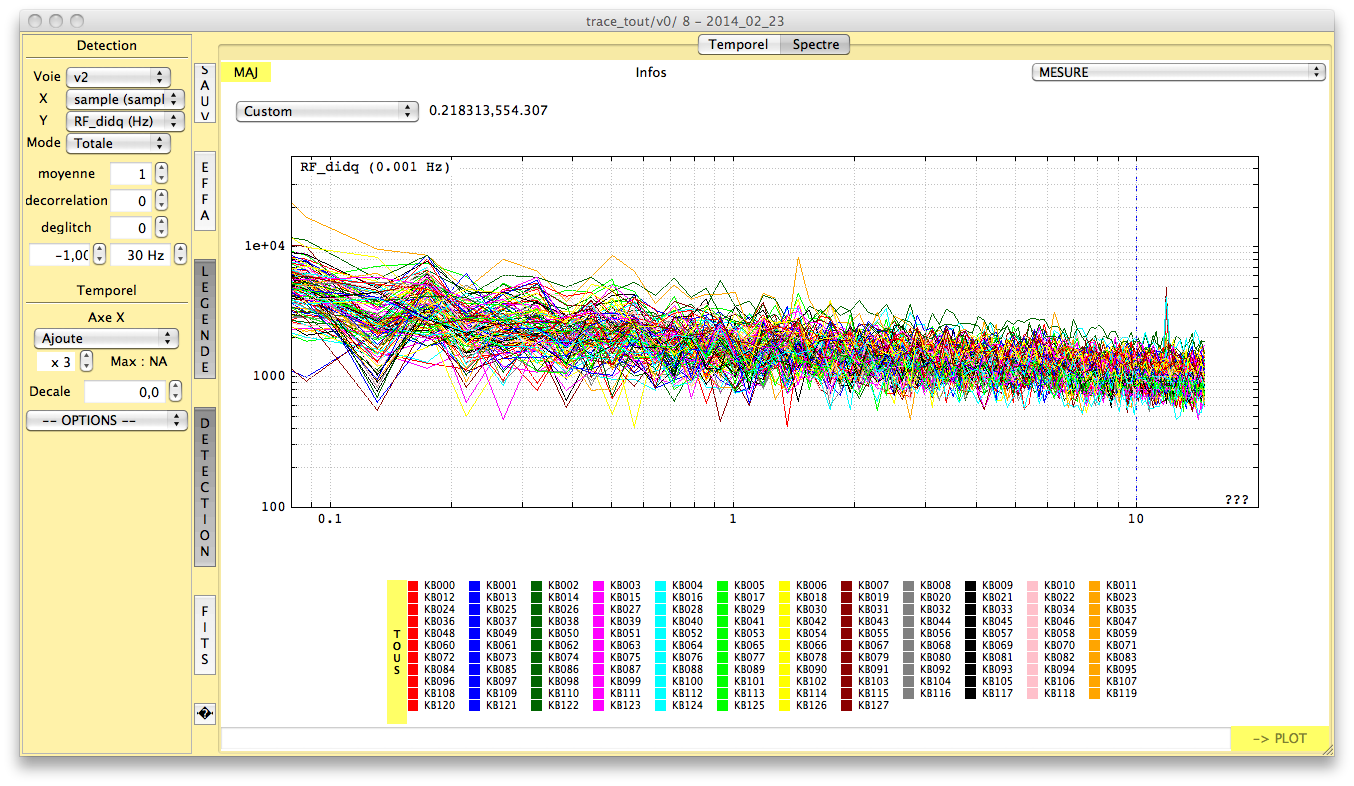Back to the NIKA run8 main page
Contents
- Friday 14th February 2014
- Saturday 15th February 2014
- Sunday 16th February 2014
- Monday 17th February 2014
- Tuesday 18th February 2014
- Wednesday 19th February 2014
- Thursday 20th February 2014
- Friday 21th February 2014
- Saturday 22th February 2014
- Sunday 23th February 2014
- Monday 24th February 2014
- Tuesday 25th February 2014
- Wednesday 26th February 2014
Friday 14th February 2014
10h00. Xavier and Alessandro arrive at the telescope. Among the NIKA2 collaboration, Philippe André too is on the mountain. Made a new parameter file FOR THE 2MM array ONLY (definitely need the sky for the 1mm).
Old configuration (2mm): DAC gains: 20-23-20-28-35. General niveau: 5.
New configuration (2mm): DAC gains: 20-23-20-38-55. General niveau: 5. Pixels 17-25: niv 6. Pixels 55 to 56: niv 6. Pixels 73 to 78: niv 4. Pixels 96 to 108: niv 6.
|
|
Figure. Left: old config (2mm), right: new config (2mm). MADE WITH WINDOW ON CRYOSTAT, TO BE CONFIRMED (see tomorrow) WITH LN2. DON'T USE THIS BRAIN!!
Strong (strange) 12Hz noise on some (e.g. 4-5) pixels. See tomorrow daily report for more on that.
PAY ATTENTION, THESE PARAMETERS ARE CHANGING AGAIN, SEE BELOW (19/02/2014).
Saturday 15th February 2014
8h00. Theoretical start of the run. Winds peaking at 40m/s, telescope stopped probably the whole morning. The ski station is closed due to the wind.
It's so windy: 
9h00. LN2 in front of the cryostat window to play at least with the resonances. "Decalage" found by the new "restore tones" is good. -22kHz and -1KHz at 1 and 2mm respectively, indicating that the param file run8.txt is well representative of LN2 temperature.
NEW PARAM FILE MADE ON LN2
LN2 configuration (1mm): DAC gains: 20-23-20-30-40. General niveau: 6. Individual levels to be adjusted on the sky but it'll be difficult. Bad pixels: too difficult, see offline data analysis.
LN2 configuration (2mm): DAC gains: 20-23-20-33-50. General niveau: 5. Pixels KB021,30,41,42,111 at niv. 6. Pixels KB073-80,83,88,111,114-116,119-120 at niv.4. Bad pixels: KB033,75,76,88,109,110.
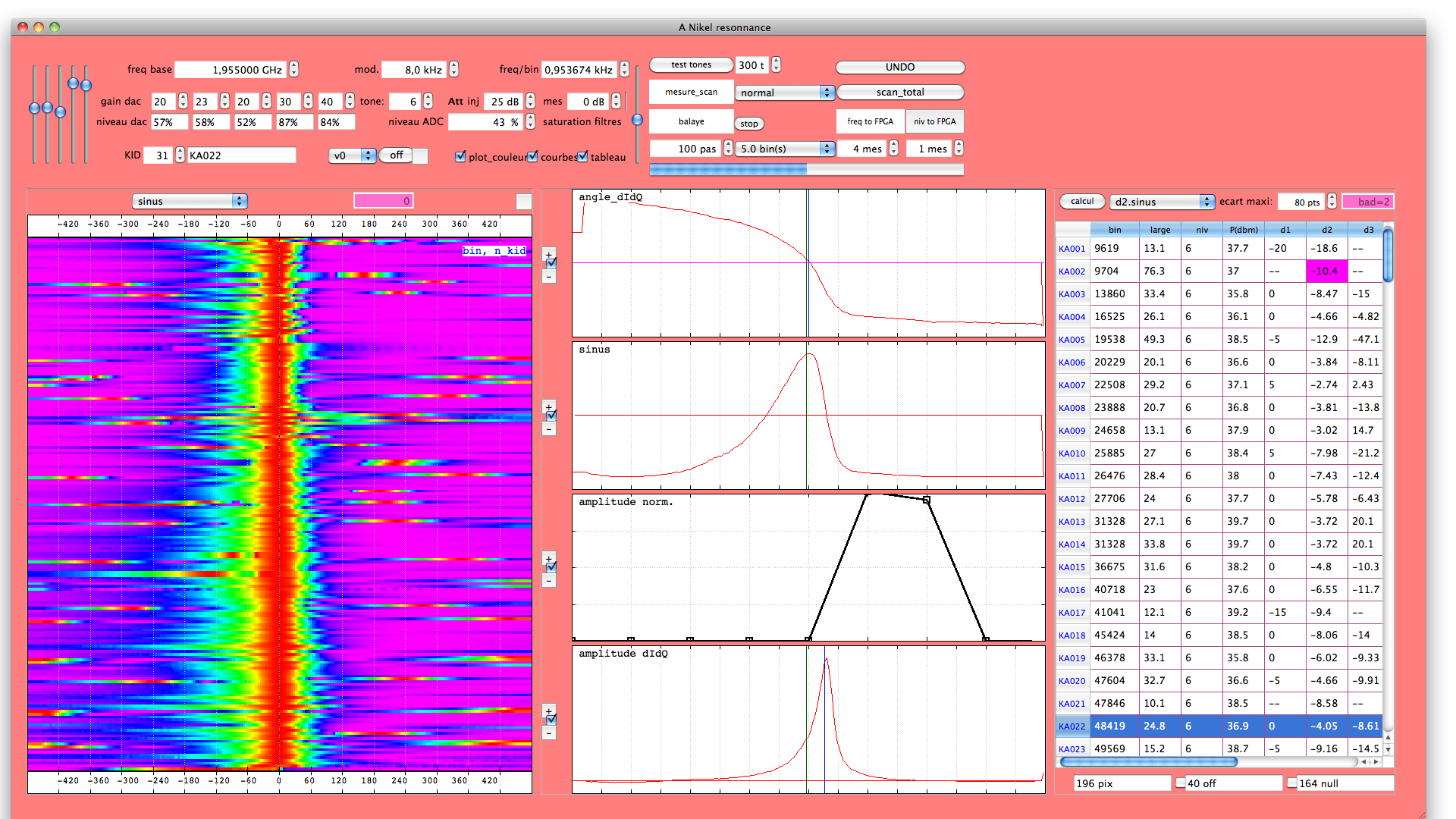
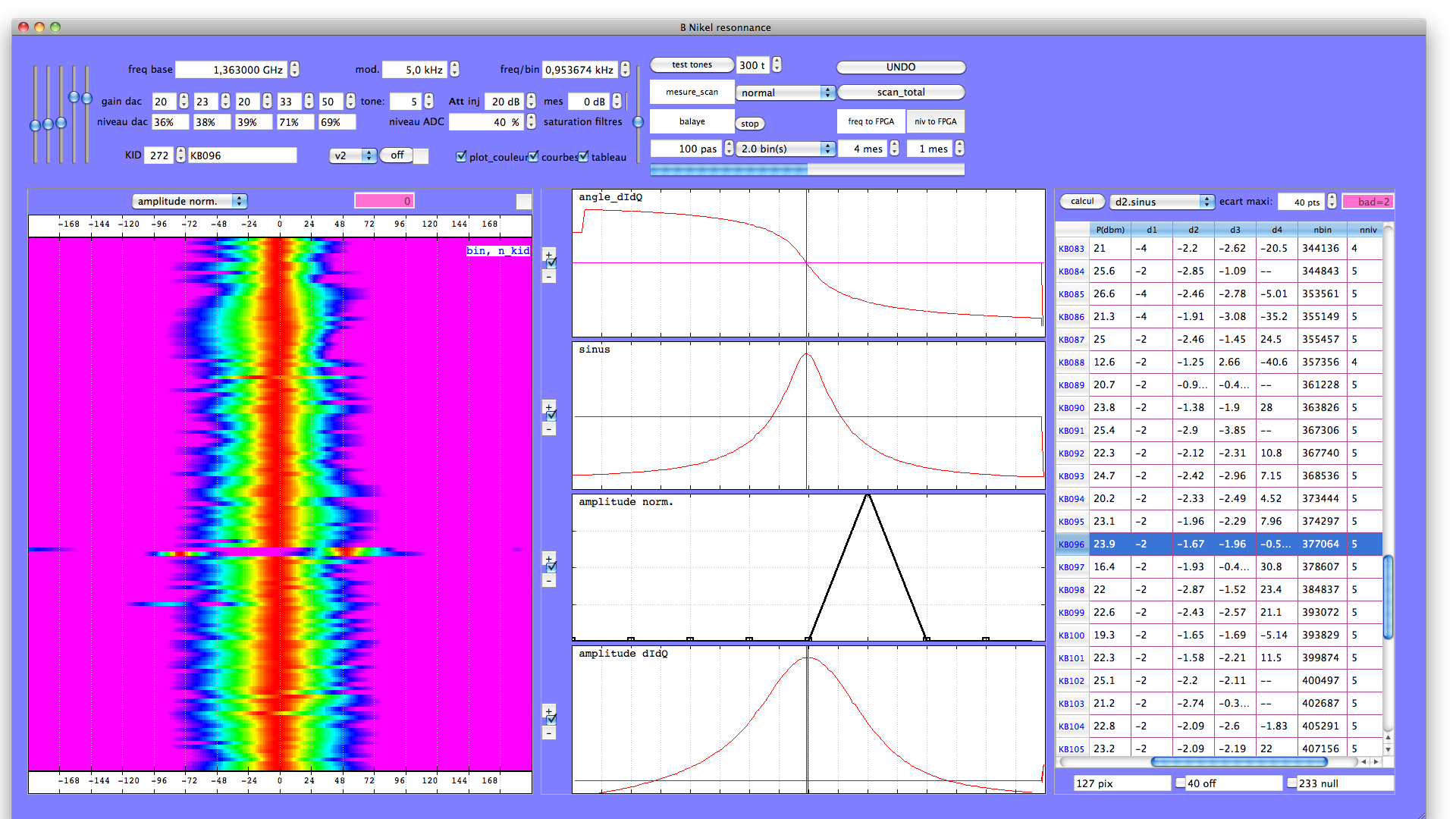
Figure. Top: 1mm new config (LN2). Bottom: 2mm new config (LN2). MADE WITH LN2 close to pupil, TO BE CONFIRMED ON THE SKY. When we can get it.
PAY ATTENTION, THESE PARAMETERS ARE CHANGING AGAIN, SEE BELOW (19/02/2014).
13h00. Wind hits 42m/s (150km/h). The telescope basement is a block of ice. Put again the window on the cryostat, "restore tones" works very well. Found a shift of -393kHz and 100kHz.
15h00. Went to the cabin to try understanding the monochromatic lines (e.g. 8Hz, 12Hz) on some pixels. Difficult to conclude since it apperars that even with the window closed (but without Al tape) you see large signals due to reflections of body temperature through the HDPE then onto the curved inner surface of the window and into the cryostat.
For comparison with the previous run7, we show below the noise spectra measured with the window on (equivalent rto roughly 180K background).
|
|
Figure. Left: 1mm noise. Right: 2mm noise. MADE WITH WINDOW ON CRYOSTAT.
Here is a photo of NIKA ready to observe (courtesy of Bilal Ladjelate)
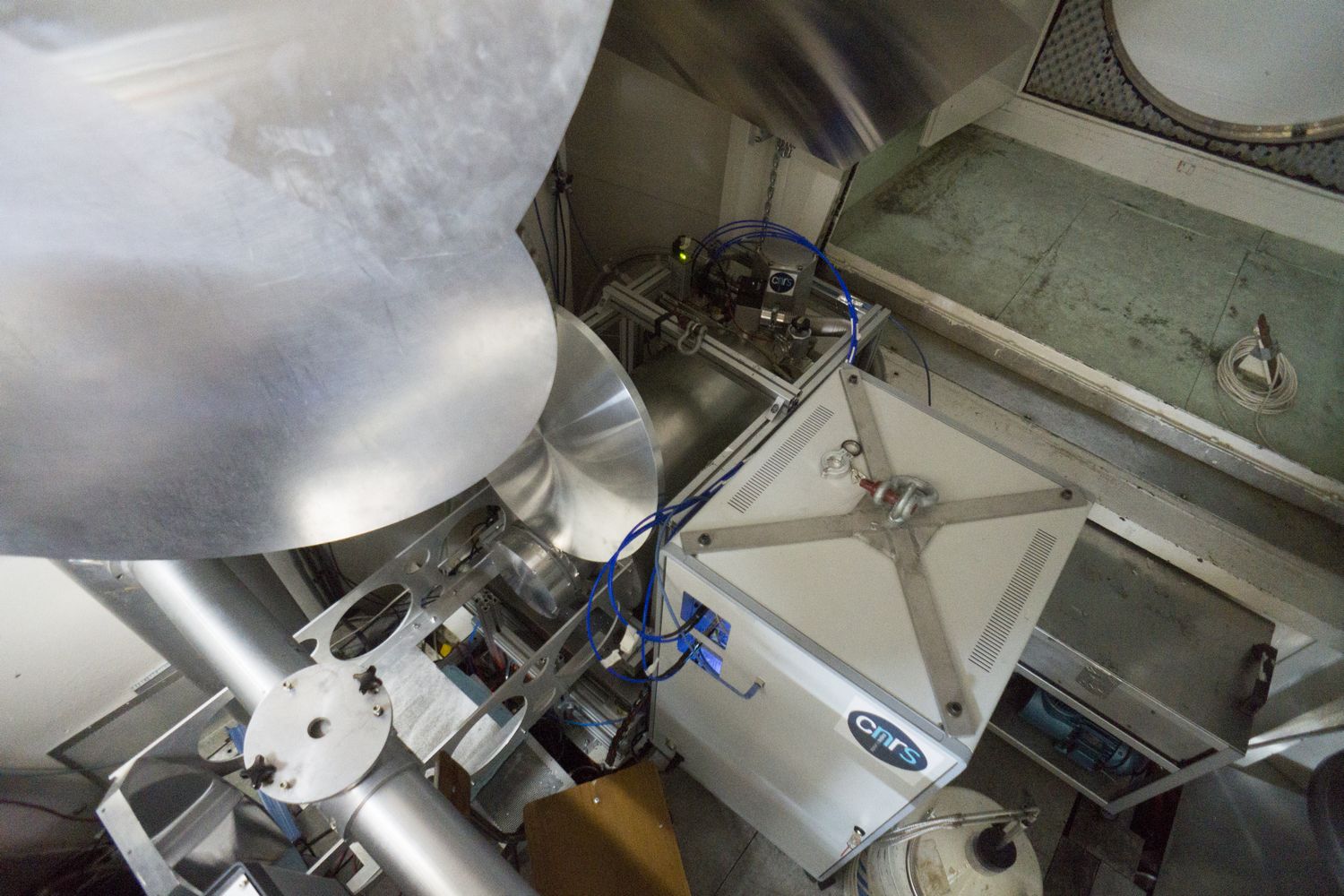
Sunday 16th February 2014
11h00. Our theoretical slot begins. Wind, snow, fog. Nothing is going to happen today. New SW version uploaded by Alain. Put heater on cryostat in fixed power instead of regulation. 23.1uW to be around 150mK but not letting it oscillate too much.
Thermal sensitivity for the two arrays has been measured by lowering the T to 130mK. So the 20mK variation made 3000Hz shift on the 1mm and 300Hz on the 2mm. The sensitivities to base T are thus 150Hz/mK and 15Hz/mK for the 1mm and 2mm respectively. Considering that the noise in T measured on the thermometer is of the order of 0.02mK RMS (over 1 minute roughly time, slower/larger drifts are not counted, will be hided into the sky noise) that gives 3Hz on the 1mm and 0.3Hz on the 2mm. Small. Completely negligible ? May be not for the 1mm at least.
Monday 17th February 2014
11h00. Nicolas and Barbara arrived. Wind still preventing moving the telescope. Cannot observe today.
13h30. Acquisition has changed again. This afternoon must recompile and restart. Param file changed (one column with angle added). PAY ATTENTION
Tuesday 18th February 2014
Observers arrived too.
Document for observers to verify the status of the NIKA instrument.
Wednesday 19th February 2014
2h00. Starting finally. Good Sky during the night, a few "lecture" errors (on some scans) preventing to use part of the data. Checked pointing.
18h00. It seems the 1mm array is a bit less sensitive that in run7 (based in run7 on a single OTF scan on APM). We don't know exactly why, but we try to polarize the 1mm array on maximum dIdQ instead of the classical (used in run7 and in the beginning of run8) 'sinus' (minimum transmission). Also, we changed slightly the powers on the sub-bands of the 1mm array. Reducing the first two and increasing the last two. Now the DAC levels for the 1mm array read: 15,15,20,35,44.
Parameter file with resonances A and B centred on 'sinus', i.e. minimum transmission
For comparison, the initial parameters file when we arrived (inherited from run 7)
From 17h30 (Local Time) we work with the IQ parameter. The 2mm array shouldn't be affected at all. IMPORTANT, WHEN USING THE SINUS PARAMETER YOU HAVE TO TUNE USING THE 'angle 0'. WHEN ON THE OTHER HAND YOU USE THE IQ PARAMETER, YOU HAVE TO TUNE (AND SET YOUR HYSTO WINDOW) ON 'angle 1'.
19h00. Remi and Juan confirmed that the new settings give better sensitivity. 25mJy*sqrt(s) now instead of 40 we had before. The 2mm performances, they confirm, are non affected being still of the order of 10mJy*sqrt(s) or better. We decide to keep these settings from now on. Important to be verified the photometry, we still use the kid_par from run7 that might have changed.
Thursday 20th February 2014
9h00. Very good night of observations. Sky very stable, NIKA and pipeline worked great all alone for the night. Few clouds coming but still blue Sky, very nice. Still the photometry to be verified (to see if the incredible numbers of the 2mm sensitivity are correct.
12h00. Nicolas, Juan, Xavier and Remi checked the photometry and found that it's OK at 2mm, like in run 7. The 1mm looks a bit more sensitive (found higher fluxes that expected, e.g. 45Jy instead of 36Jy on Uranus). Good news. May be the numbers we gave yesterday are true, we will see. Many sources are detected.
19h00. Still OK, tuning, observing. Xavier left.
Friday 21th February 2014
Morning. Big changement in the team at the telescope. Leaving: Barbara, Alessandro (afternoon). Arrived: Remi, Martino.
13h00 Started observations.
![]() Edit conflict - other version:
Edit conflict - other version:
Saturday 22th February 2014
|
|
Figure. Detectors noise at tau = 0.1 Left: 1mm, right: 2mm.
All day. Observations going on at full speed, the tau keeps being extremely low (generally below 0.1!!).
Morning The sensitivities achieved are such that 10 minutes of observation on SXDF have given maps qualities comparable to the ones obtained in November 2012 after roughly 4hrs at comparable taus!
Evening. Astronomers (and we too!) were very excited after seeing a hint of the filament in Tau-miz8b already with the quick look software. The filament was detected in both bands.
|
|
Figure. Detectors noise at tau = 0.01 Left: 1mm, right: 2mm.
Sunday 23th February 2014
Morning. Tau still stays very good. We are getting used to space-like conditions! There are rumors citing sensitivity values that are almost incredible... for security reasons we do not report them here waiting for official confirmations, but we are very optimic now.
11h00 Fred left us on ski.
19h00 Observations stopped due to wind.
Monday 24th February 2014
11h00 No observations during the night. Telescope is still stopped due to bad weather condition (it is snowing, also strong wind). Juan and Laurence have joint us. Waiting for good conditions..
23h00 Back in observation mode but weather not as good as before. Overnight a bit of SZ plus various other projects.
Tuesday 25th February 2014
11h00 We stop for the technical time.
16h00 Restart, beginning with a map on Uranus. During the technical time we lost the connection to the thermometers. The regulation stopped working consequently. So the very first scan after restart (a short Lissajous on a secondary calibrator, not yet Uranus!) has been made at Tbm=100mK (but, it was launched even before retuning..). Now tones restored and thermometers back. Helium in the trap refilled, we should be fine now until friday. On a side note: pictures of the NIKA2 cryostat have inspired awe (and a pretty justified amount of fear..) among the IRAM staff (and among the NIKA team as well!). It's really beautiful!
